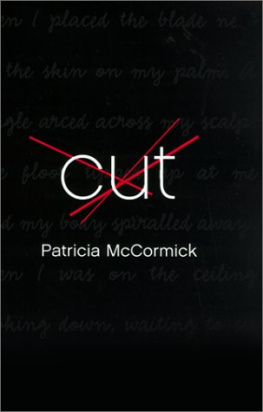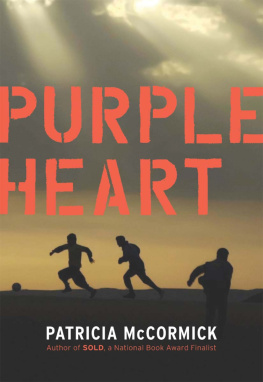


namelos
www.namelos.com
Copyright 2000 by Patricia McCormick
Published by arrangement with Boyds Mills Press, Inc.
All rights reserved
First namelos edition, 2009

This work is licensed only for use by the original purchaser.
Making copies of this work or distributing it to any unauthorized person
by any means, including without limit email, file transfer, paper print out,
or any other method is a violation of international copyright law.

This Library of Congress CIP Data refers to the hardcover edition
McCormick, Patricia
Cut / Patricia McCormick.1st ed.
p. cm.
Summary: While confined to a mental hospital, thirteen-year-old Callie
slowly comes to understand some of the reasons behind
her self-mutilation, and gradually starts to get better.
[1. Self-mutilationFiction. 2. Emotional problemsFiction.
3. Psychiatric hospitalsFiction.
4. Family problemsFiction.] I. Title.
PZ7.M13679 Cu 2000
[Fic]dc21 00-03484
Table of Contents
For Meaghan
Im deeply grateful to The Writers Room, an oasis of serenity in downtown New York; to the Vermont College graduate program in writing for young people, which supported my work at a crucial juncture; to my friends Bridget Starr Taylor, Hallie Cohen, Annie Pleshette Murphy, Chris Riley, Joan Oziel, Joan Gillis, Meg Drislane, Anna An, and Cathy Bailey, who believed in this story even when I didnt; to Katya Rice who copy edited with sensitivity and good cheer; to Carolyn Coman, the first person to call these pages a book and to Stephen Roxburgh, my editor and publisher; and most of all to my family, Paul, Meaghan, Matt, and Brandon, who have taught me so much about love and honesty.


You say its up to me to do the talking. You lean forward, place a box of tissues in front of me, and your black leather chair groans like a living thing. Like the cow it used to be before somebody killed it and turned it into a chair in a shrinks office in a loony bin.
Your stockinged legs make a shushing sound as you cross them. Can you remember how it started? you say.
I remember exactly.
It was at the last cross-country meet, right around the four-mile mark. Everybody had passed me, just like the week before and the week before that. Everybodyexcept a girl from the other team. We were the only ones left in the last stretch of the course, the part that winds through the woods and comes out behind the school. Our shadows passed along the ground slantwise; slowly they merged, then her shadow passed mine.
The soles of her sneakers swam up and down in front of me, first one, then the other, a grid of ridges that spelled out the upside-down name of the shoe company. My steps fell in time with hers. My feet went where her feet had just been. She leaned in around a corner, I leaned in around a corner. She breathed, I breathed.
Then she was gone.
I couldnt even picture her anymore. But what scared me, really scared me, was that I couldnt remember the moment when Id stopped seeing her. And I knew then that if I couldnt see her, no one could see me.
Sounds from the track meet floated by. A whistle trilling. Muffled applause, the weak sputtering of gloved hands clapping. I was still running, but now I was off the path, heading away from the finish line, past the cars in the parking lot, the flagpole, and the HOME OF THE LIONS sign. Past fast-food places and car repair shops and video stores. Past the new houses and the park. Until, somehow, I was at the entrance to our development.
It was starting to get dark now, and I slowed down, walking past houses with windows of square yellow light where mothers were inside making dinner, past houses with windows of square blue light where kids were inside watching TV, to our house, where the driveway was empty and the lights were off.
I let myself in and flipped the light switch. There was an explosion of light. The kitchen slid sideways, then righted itself.
I leaned against the door. Im home, I said to no one.
The room tilted left, then right, then straightened out. I grabbed hold of the edge of the dinner table and tried to remember if we stopped eating there because it was piled with junk or if it was piled with junk because we stopped eating there.
On the table there was a roll of batting, a glue gun, a doily, a 1997 Krafty Kitchens catalogue. Next to the catalogue was a special craft knife with the word EXACTO on the handle. It was sleek, like a fountain pen, with a thin triangular blade at the tip. I picked it up and laid the blade against the doily. The little knots came undone, just like that. I touched the blade to a piece of ribbon draped across the table and pressed, ever so slightly. The ribbon unfurled into two pieces and slipped to the floor without a sound. Then I placed the blade next to the skin on my palm.
A tingle arced across my scalp. The floor tipped up at me and my body spiraled away. Then I was on the ceiling looking down, waiting to see what would happen next. What happened next was that a perfect, straight line of blood bloomed from under the edge of the blade. The line grew into a long, fat bubble, a lush crimson bubble that got bigger and bigger. I watched from above, waiting to see how big it would get before it burst. When it did, I felt awesome. Satisfied, finally. Then exhausted.
I dont tell you any of this, though. I dont say anything. I just hug my elbows to my sides. My mind is a video on fast-forward. A video with no soundtrack.
And finally you sigh and stand up and say, Thats all we have time for today.
Twice a day we have Group. Group therapy according to the brochure, they give you at the admissions office, is the keystone of the treatment philosophy here at Sick Minds. The real name of the place is Sea Pines, even though there is no sea and there are no pines. My roommate, Sydney, who has a nickname for everything, calls it Sick Minds. Her nickname for me is S.T., for Silent Treatment.
We, by the way, are called guests. Our problems are called issues. Most of the girls are anorexic. Theyre called guests with food issues. Some are druggies. Theyre called guests with substance-abuse issues. The rest, like me, are assorted psychos. Were called guests with behavioral issues. The nurses are called attendants. And the place is called a residential treatment facility. It is not called a loony bin.
There arent assigned seats in Group, but people tend to sit according to issues. The food-issue guestsTara, a really skinny girl who has to wear a baseball cap to cover a bald spot where her hair fell out, and Becca, another really skinny girl who wears white little-girl tights that pool around her ankles and who came straight here from a hospital after she had a heart attack, and Debbie, a really, really overweight girl who says shes been here the longestsit in a cluster of orange plastic chairs next to Claire, the group leader. The substance-abuse guestsSydney, who says shes addicted to every drug shes ever tried, and Tiffany, who seems normal but is here instead of going to jail for smoking cracksit together on the other side of Claires chair.
Next page













